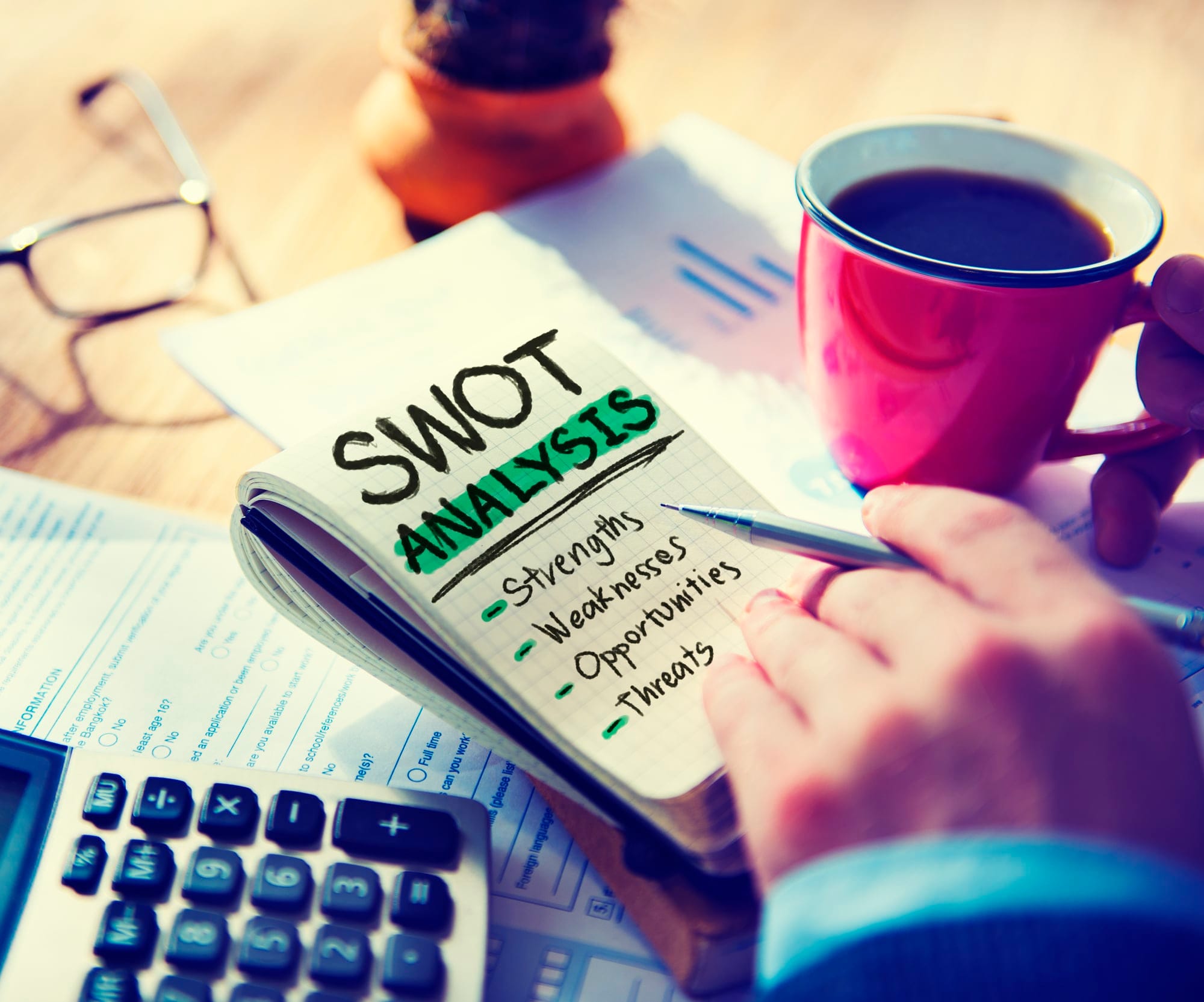How much do you know about your competitors?
You can learn quite a bit about their strengths and weaknesses. Having this information helps develop a strategic plan and a solid advantage for your own company. All that’s left is to identify opportunities and threats.
We know the two perfect analyses for this: Competitor analysis and SWOT analysis. And today I'll be demonstrating the benefits of a Competitor SWOT analysis, combining the strengths of both studies.
Competitor analysis for the right information
This analysis is crucial for business and marketing plans. It involves the study of your competitors, what they offer, how they offer it, and what their customers say about their services. Depending on your industry, you could have dozens of competitors. But you should limit the list to the top three or four for brevity.
You may want to answer these preliminary questions first:
- Who are your top 3-5 competitors, and why should they be included in the top?
- What products or services do they sell? How do they sell them?
- What are their past sales and marketing strategies? Has it differed from the past?
These questions give you the basics to get started. When you have each of these questions answered, it’s time to intertwine SWOT analysis into the mix.
How to use SWOT analysis to your advantage
If you have studied business or worked in the corporate world, you must know about SWOT analysis. Businesses across the globe use SWOT analysis.
SWOT analysis is a strategic tool that’s applicable for businesses, industries, and even oneself. The premise is simple. Whatever your topic of choice, identify the strengths, weaknesses, opportunities, and threats. In this case, we’re applying SWOT analysis to your competitive analysis.
In a SWOT analysis, strengths and weaknesses are the internal factors. At the same time, opportunities and threats are external factors.
Intertwining SWOT analysis with competitive analysis
For strengths, compare your products with theirs. You can examine media attention, such as awards they’ve received or reviews found on their website or forums.
Write down everything and then compare. Does your company have similar strengths? Have people provided similar feedback about your products? If the similarities are small, write down why that is. What do you offer, and how do you offer it? What are people saying about your product? These are your strengths.
For weaknesses, you’ll compare your products. Would you ever consider their approach to selling or sales? Why or why not? Also, look at negative reviews. Some customers may be nitpicky, but that’s where opportunities are hidden.
Now, try to identify threats. What’s threatening about the competition? Are they extremely well known? Could they buy out the smaller, weaker competition?
Organizations use SWOT analysis as a strategic tool since it provides a complete snapshot of the current situation. For example, Coca-Cola can strategize its operations by conducting a SWOT analysis. The SWOT analysis will identify the strengths of Coca-Cola.
For example, the brand has a diverse portfolio and a large customer base. These are the internal factors of the brand that count as its strengths.
After that, the SWOT analysis will highlight the weaknesses of Coca-Cola, such as the brand contributes to environmental waste and its beverages are considered harmful to health.
Besides that, the SWOT analysis will also highlight the opportunities for Coca-Cola. For example, Coca-Cola can increase its market share by acquiring smaller brands in the same industry.
In the end, the SWOT analysis will highlight the threats that are present for Coca-Cola, such as the global recession that is predicted to hit. It acts as a threat for Coca-Cola since, during the recession, the demand for Coca-Cola might drop.
This way, SWOT analysis provides essential insights that help businesses make informed decisions, plan a strategy to avail the opportunities, and deal with the present threats.
Besides conducting a SWOT analysis on itself, businesses also conduct a SWOT analysis on the industries to analyze the strengths, weaknesses, opportunities, and threats an industry faces.
SWOT analysis of an industry helps businesses decide whether to enter or exit an industry. Now that you have become aware of what SWOT analysis is let's proceed further and discuss the four essential steps to conduct the SWOT analysis.
Step 1: Identifying Competitor Strengths - Uncovering the Competitive Edge
This is the first step of the SWOT analysis. It holds great significance since this step highlights the strengths of the competitor.
Assessing the strengths of the competitor is very important. Suppose a business is unaware of the strengths of its competitor. In that case, it can't form a strategy to get ahead of its competitors.
The first step to assess the competitor's strengths is to gather information about the competitor. Before doing that, it is important to identify the direct and indirect competitors.
Direct competitors would be businesses in the same industry and offering similar products and services. On the other hand, indirect competitors are businesses that provide substitutes or alternative products.
After identifying the competitor, it is essential to analyze its strengths. Strengths are the factors that provide a business with a competitive edge over its competitors.
For example, if you conduct a SWOT analysis, you must identify your competitor's strengths. You have to analyze whether your competitor has a strong and loyal customer base or a diverse portfolio that distinguishes it from your business.
After identifying your competitor's strengths, you must compare them with your business's.
The purpose of this comparison is to highlight the areas where your business lacks compared to your competitor because these are the areas where your competitor has a competitive edge on your business.
Identification of the strengths of your competitor is important so that you can develop the same strengths to compete with your competitor.
Businesses keep a close eye on the strengths of their competitors so that they can develop the same strengths. Earlier, we have seen that Apple accused Samsung of copying the designs and features of its phones.
The resemblance between some of the iPhones and Samsung phones is uncanny. Samsung has probably taken inspiration from some of the iPhones and adopted some of their features because their distinguished features were the strength of iPhones.
Samsung analyzed and identified the strengths of Apple, which were the distinguished features in iPhones, and adopted the same features to give Apple a tough time.
Now that we have discussed the first step of the SWOT analysis, which is identifying the competitor's strengths, let's proceed further and look at the second step of the SWOT analysis.

Step 2: Revealing Weaknesses - Where Your Competitors Stumble
The second step of the SWOT analysis is very crucial. In this step, the business has to identify and analyze the weaknesses of its competitors. By revealing the competitor's weaknesses, businesses can form a strategy to capitalize on them.
The first step to identify the competitor's shortcomings is to collect data on the competitor's weaknesses.
For example, suppose Honda is conducting a SWOT analysis on its competitor, Toyota. In that case, Honda has to identify the weaknesses of Toyota in the second step of the SWOT analysis.
The weaknesses of Toyota identified by Honda may include the limited global presence of Toyota and the lack of technology used in the vehicles manufactured by Toyota.
After that, Honda needs to analyze its weak points. By doing so, Honda can compare the areas where Toyota is weak, and Honda is strong. After analyzing this, Honda can form strategies to exploit Toyota's weaknesses.
The weaknesses of Toyota are an opportunity for Honda to capture the market. However, before exploiting Toyota's weak links, Honda needs to analyze whether these weaknesses are major or minor.
Minor weaknesses can always be overcome by putting in a bit of effort. However, major weaknesses take time to fade away. Honda needs to form a strategy against and exploit Toyota's major weaknesses.
For example, Toyota lacks in innovation and technology. It is currently six years behind Tesla when it comes to technology. This is a major weakness of Toyota and can't be fixed overnight.
After identifying this weakness of Toyota in the second step of the SWOT analysis, Honda can focus on its technology to capture Toyota's market share.
Dove is one of the brands that has capitalized on the weaknesses of its competitors amazingly.
All the other beauty brands focused on highlighting the characteristics of their products but never on portraying real-life stories of people, which made customers unable to relate with those brands.
Dove considered this a weakness of the beauty brands and focused on portraying real-life stories of the people with the message that real internal beauty matters the most.
People resonated with Dove's marketing campaign, and Dove's customer base increased. In this way, Dove managed to exploit the weakness of its competitors in its favor.
After discussing the second step of the SWOT analysis in detail, let's proceed further and discuss the third step of the SWOT analysis.
Step 3: Exploring Opportunities - Navigating Competitive Advantages

Other than identifying the strengths and weaknesses of the competitors, businesses also have to look for opportunities in the market. The third step of the SWOT analysis is all about exploring the opportunities.
Businesses should always look for avenues to expand their customer base and increase their market share. Every business gets an opportunity to grow from the external environment. However, a business can only avail of such opportunities if they are vigilant.
A business can explore its opportunities by researching and analyzing the current and emerging trends in the market.
For example, the Japanese clothing brand Uniqlo came into existence after its owner shifted from manufacturing conventional clothes to casual clothes because they were in fashion.
In this case, the owner of Uniqlo anticipated the emerging trend of casual clothing in the early 1980s. As a result, the brand got a competitive advantage over its competitors. It became one of Japan's biggest casual clothing brands.
Besides that, businesses must also keep a close eye on the political landscape since many opportunities emerge from there.
For example, as Pakistan's economic and political conditions deteriorated, many textile manufacturers producing products for Nike and Adidas shifted their operations from Pakistan to Bangladesh.
These businesses flourished by availing of this opportunity since operational costs in Bangladesh were less than in Pakistan.
Similarly, businesses need to conduct surveys to see what people want. By keeping close contact with the customers and staying aware of their needs, businesses can get an opportunity to expand and increase their customer bases.
Moreover, businesses also need to analyze the markets growing economically and demographically. For example, the African market is currently emerging, providing an opportunity for businesses to invest.
Businesses need to tap the untapped economies to succeed. Furthermore, globalization has created many opportunities for businesses to collaborate with big brands and celebrities across the globe.
Other than that, technological advancements always allow businesses to expand. For example, the recent emergence of Artificial Intelligence (AI) has allowed businesses to cut operational costs by automating their work through AI.
Since we have explored the third step of the SWOT analysis completely, let's look at the final step of the SWOT analysis, which teaches us how to identify the threats to businesses.
Step 4: Identifying Threats - Anticipating Challenges and Risks

The last step of the SWOT analysis holds great significance since it focuses on the identification of threats that are present for businesses.
Threats are the dangers that are present in the external environment for businesses. Businesses need to identify the threats and take appropriate measures to mitigate them.
Threats can be in any form. They can be in the form of competitors, economic challenges, or the dynamic nature of the market. However, to succeed, businesses have to overcome all the threats.
Businesses first need to identify what types of threats exist in the market. If a business feels threatened by changing consumer preferences, it must find ways to deal with this problem.
For example, businesses operating in the clothing industry face many challenges since fashion keeps changing. To deal with this problem, they ensure they are responsive to the change in consumer preferences.
Similarly, economic challenges such as global recession can also act as a threat to many businesses. In that case, businesses must save ample money to keep running during financial crunches.
Furthermore, some businesses perceive technological changes and innovation as a threat. For example, recently, as AI has emerged, human capital is being replaced with AI.
Businesses can deal with this threat by adopting the latest technologies and using them to increase their efficiency and productivity.
At the end of the final step of the SWOT analysis, businesses have to identify and prioritize their threats to use a coherent strategy to deal with them.
Understanding Competitor SWOT Analysis: Conclusion

Today's article discussed a SWOT analysis and how businesses use it as a strategic tool to form strategies and make informed decisions.
SWOT analysis identifies strengths and weaknesses, opportunities, and threats that a business or an industry faces.
Businesses use this strategic tool to get a snapshot of the current situation. They use it to see how different external and internal factors impact the operations of a business or an industry.
After making our readers aware of the significance of SWOT analysis, we proceeded further. We discussed the four essential steps required to conduct a SWOT analysis.
In the first step, businesses need to assess their competitors' strengths. Identification of the strengths of competitors is important for businesses since it makes them aware of their competitors.
The second step is to identify the weaknesses of your competitors. By doing so, businesses get to know where their competitors lack and form strategies to exploit their weaknesses.
The third step of the SWOT analysis focuses on identifying the opportunities for a business. Finally, the last step focuses on identifying the threats to the business and taking measures to mitigate those steps.
Obviously, both the SWOT analysis and competitor analysis require brainstorming, research, and comparison. But the results are worth it.
You’ll learn:
- Where and how to position yourself as a business (even in busy markets)
- What your competitive advantage is
- Which threats from your competitors are minor and which ones are fatal
- The weaknesses of your own company
- Easy places to build opportunities for the future
The results from your competitor and SWOT analysis provide critical information for your corporate strategy. It’s up to you to find opportunities and work it in your favo









